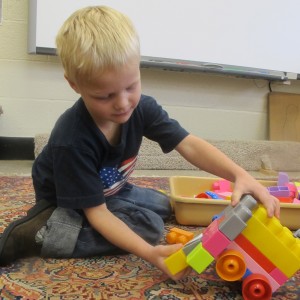Pre-K Pilot Preview: How Are Counties Finding Participants?
The clock is ticking.
Indiana’s pre-k pilot program launches in four of the five participating counties in January, a little less than a month away. But many leaders in those counties say they’re still finalizing the details – crossing the T’s and dotting the I’s of fundraising, getting providers up to speed and children into the classrooms.
- Pre-K: The Final CountdownPre-k leaders in Allen, Lake, Marion and Vanderburgh counties are preparing to welcome eligible low-income four-year-olds as part of an early launch for the state’s pilot program. As the start date gets closer, what sort of last-minute preparations are leaders making?Download
Timeline Troubles?
The Family and Social Services Administration (FSSA) released applications for providers who want to participate on November 12, and grant applications for eligible families went out the following week. Those are due December 15.

Rachel Morello / StateImpact Indiana
Eligible four-year-olds in Allen, Lake, Marion and Vanderburgh counties will be able to start pre-k in January through the state's pilot program.
Dennis Rittenmeyer, executive director of ONE Region in Lake County, leads the area’s pilot efforts. He says he’s concerned there’s a lot left to do and only a little time in which to do it.
“That [application] material just came out, it was supposed to have been out a long time ago. We’re supposed to start in six weeks!” Rittenmeyer exclaims. “They have to find a provider that has space, that’s a big deal. We’re still dealing with issues that the state and we ourselves are working through.”
Melanie Brizzi, the FSSA’s Director of Early Childhood, says her organization is following the timeline as planned, and that she feels families do have enough time to get their business in order and their application submitted.
“The application process is pretty simple, there are folks available to help with that,” Brizzi says. “You can only move so fast when you’re opening new classrooms, hiring new teachers, doing training and getting prepared.”
Numbers Matter
The FSSA expects the first group of children enrolling in January will be much smaller than the group coming in next fall. Brizzi explains that this has everything to do with capacity: how many slots for new kids providers have available. We don’t know those exact numbers yet, but Brizzi says it depends on who’s really ready to serve kids appropriately.
“We want to make sure that we’re starting to serve children as quickly as possible, but that there is more than enough high quality pre-k programs available,” Brizzi explains. “This is a brand new program, so building capacity just takes time. If you give them six to eight more months, before the start of the 15-16 school year, that capacity is going to significantly grow, because we are working with local communities.”
The FSSA has dispatched quality coaches to help existing programs reach the state’s Paths to Quality standards. They’re also offering teacher training.
One way Lake County is trying to circumvent the issue of capacity is linking onto providers that are already in operation. Karen Carradine, another Lake County leader and vice president of HeadStart for Geminus Corporation, pitches it to potential participants like this:
“Look you’re already open, and you may already have an opening, so now this is just a child that’s going to come into the process you already have in place,” Carradine explains. “I have a base program, its easier for me to start in January, and bringing in that pre-k will be a supplement to that.”

COSI Columbus / (Flickr)
The number of children participating providers are able to serve in January will depend on the spaces available, according to FSSA officials.
“The January group, we’re only going to have half a year. By September we will be able to help many more of the school districts create their base,” Carradine says.
The same is true in Allen County, where leaders hope to serve at least 30 to 50 eligible kids during the initial launch. John Peirce, a consultant to the United Way of Allen County, spearheads the pilot, and he says another piece of the puzzle is figuring out where kids will be placed. He says he’s getting help from neighborhood housing authorities.
“They can identify the ages of individuals in the different housing units in they manage so that we can target our appeals to families, especially around providers that are close by,” Peirce says. “We know transportation can be an issue, so part of our effort will be trying to target our marketing to families in areas that are in the same neighborhoods as eligible providers.”
Leaders in Allen County also developed a one-page flyer, with the help of FSSA, to distribute to interested families. Peirce says his colleagues are attempting to reach families however they can to spread the word.
“We’re trying to engage churches, providers themselves, we’ve got folks trained how to answer the phone and answer questions…the list goes on!” Peirce says.
‘We’re All Anxious To Learn’
It’s no secret who’s eligible in the Lake County area. Head Start in Northwest Indiana has a wait list of more than 1000 families. The county hopes to serve 100 to 150 of those kids in January.
[pullquote] …as we know in all things that are human bound, there are levels of degrees of eligibility. – Karen Carradine, Lake County Pre-K leader[/pullquote]
Carradine says for her and everyone involved in each of the counties, the goal is to reach those families most in need.
“There is a shelf that’s given to who is eligible, but as we know in all things that are human bound, there are levels of degrees of eligibility, and so I think with lottery that kind of tears at the fabric of that,” Carradine says.
John Peirce agrees, and says he’s excited to get his feet wet.
“We’re anxious to learn from actually doing the work, we think we’ll learn lots more by doing it than sitting back and trying to plan,” Peirce says. “The way we look at this is, we’re going to start where we are and we’re going to move up from there. So we’re all anxious to learn, anxious to find out what we discover about the outcomes that we can produce as well.”
The FSSA will select kids to fill each county’s open slots through a random lottery drawing, scheduled for December 17. After that, the FSSA will send names of selected families to pilot leaders.
While county leaders wait, there’s still plenty to do. Next week, we’ll take a look at how counties are finalizing the funding leading up to the launch.